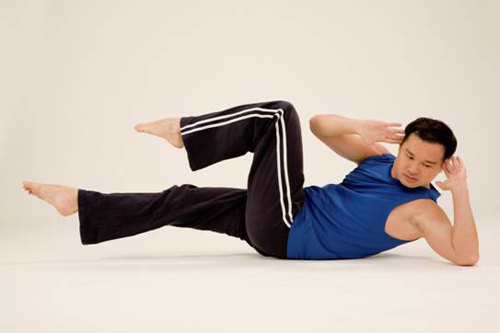Part 6 of 6 in the series of articles about Abs vs. Thighs

If you’ve been following the series of articles I’ve written on Abs vs. Thighs for improving Pilates exercise technique and core conditioning, this is the final post in this series of articles on Abs vs. Thighs.
Many people believe their doing effective Ab work, when in fact their legs are really working harder than their Abs! For twisting exercises and Oblique work, not only do the Thighs try to help, but a lot of the time the arms and shoulders are doing most of the pulling to twist (which isn’t very effective for core conditioning.) And if the arms aren’t doing all the work…the hip hikes up to meet the shoulder restricting use of your lower abs and eliminating the anchor point of a stable pelvis to maximize rotation and effective twisting of the spine.
I’ve done quite a bit of prep work in the first 5 articles , and given you exercises to practice to help feel the difference between using your Abs vs. Thighs to curl the head and shoulders up, or Abs vs. Thighs to lift and lower the legs. Now let’s think about Abs vs. Thighs during Rotation of the spine and Oblique work to help you make the most of your core training.
In a Pilates Mat Class there are many twisting exercises where Obliques vs. Quads can be a factor in how well you are able to safely execute an exercise.
- Criss-Cross in the Series of 5
- Corkscrew
- Saw
- Seated Twist
Moving to twisting exercises on the Pilates Reformer: Stomach Massage with a Twist, and Short-Box Twist give you two more challenging exercises to practice for rotation.
If the Quads grip to initiate twisting, it lifts the thigh bone to the top of the socket, which hikes a hip up and shoves the pelvis out of the square and stable position needed to find the Oblique’s and begin twisting from the waist up. When the hip hikes, there is not enough joint space for the Lumbar spine to rotate, so we skip over most of the spine and just crank the shoulders around!
A lot of people think they are using their Oblique’s, when in fact they’ve so over-conditioned their Quads and QL (Quadratus Lumborum – low back muscle) that the Oblique’s are really doing very little work. One hip will hike up as they twist, rather than true rotation of the spine lifting up away from the pelvis.
Here are a few Pilates exercise tips to help you identify if you’re using your Oblique’s effectively, or relying on your Quads & QL to twist:
Discover how these simple exercise strategies can help change your habits and improve your technique for a terrific twist.
Criss-Cross Abs – Sitz Bones Hug A Ball
Use this exercise to help keep your Hamstrings actively engaged to lengthen the sitting bones towards the heels and avoid the QL engaged hip-hike while you twist.
- Lay on your back, with knees bent and the backs of the calves resting on the ball, hands behind the head.
- Feel the ball held snugly against your sitting bones.
- Think about using your Hamstrings to pull your butt towards the heels to press the Sitz bones into the ball and keep the lower back lengthened.
- Inhale & Exhale to KG Curl the head and shoulders up, keeping the Sitz bones pressing against the ball and lengthening towards the heels.
- Inhale twist from the waist up to the right, Exhale untwist to center.
- Inhale twist to the left, Exhale untwist to center.
- Repeat, alternating sides 8-15 repetitions.
To Twist Right:
- The right Hamstring/Sitz bone reaches to the right heel.
- The right Internal Oblique’s and left External Oblique’s contract to bring the left shoulder towards the right hip.
- Pelvis stays still, back of the legs active, front of the legs relaxed, Abs pull up and away from the legs to rotate the torso.
To Twist Left
- The left Hamstring/Sitz bone reaches to the left heel.
- The left Internal Oblique’s and right External Oblique’s contract to bring the right shoulder towards the left hip.
- Pelvis stays still, back of the legs active, front of the legs relaxed, Abs pull up and away from the legs to rotate the torso.
Tips to Improve Your Exercise Technique for Twisting
- Be sure the Hamstrings stay engaged to keep the butt lengthening to the heels.
- If you start to twist and one hip hikes up your QL took over to pull your hip up to your ribs. Be sure the pelvis and hips stay flat and squared up on the mat.
- The Hamstring pulling to the heel is the anchor point for the thigh bone so the Oblique’s can lift away from the legs to facilitate functional rotation of the spine.
- Your right Hamstring will work harder to stabilize when twisting Right.
- Your left Hamstring will work harder to stabilize when twisting Left.
- To twist right -feel the Abdominals pull up and in on the right, from the inside on the right side of the pelvis towards the right bottom ribs (keeping the ribs lifting up off the pelvis.
- To untwist and return center – feel the left side of the low Abdominals pull up and in to bring the spine and ribcage back to center. Now this side is active and ready to keep working to twist you to the left.
- Hold onto, or deepen the curl every time you pass through the center.
This is the feeling you should have when doing any spine rotation exercise whether you are lying down, seated, or standing. Find it here with the help of the ball, and then apply it to all your other spine twisting exercises.
Discover the difference length with strength makes for improving pelvis stability and maximizing the health of your spine with good use of your Oblique’s to twist. Feel the difference… Oblique’s vs. Quads & QL to make the most of twisting exercises during your workouts.
********
If you’ve missed the first 5 articles in this Abs vs. Thighs series, here are the links to the previous articles:
1st Article: Abs vs. Thighs: Which Muscles are Really Working to Strengthen Your Core?
3rd Article: Abs vs. Thighs: For Effective Core Conditioning – Strengthen the Hamstrings & Glutes
4th Article: Core Conditioning Exercises Tips to Improve Pilates Exercise Technique (Abs vs. Thighs: The Pilates Hundred Exercise with Feet in Straps or Leg Springs)


0 Comments